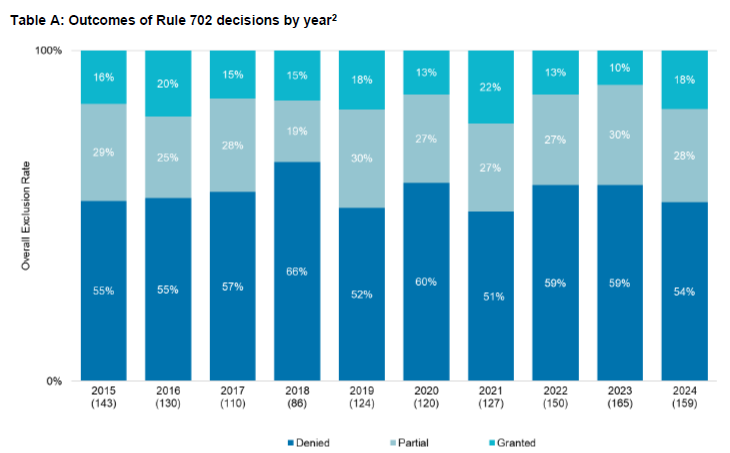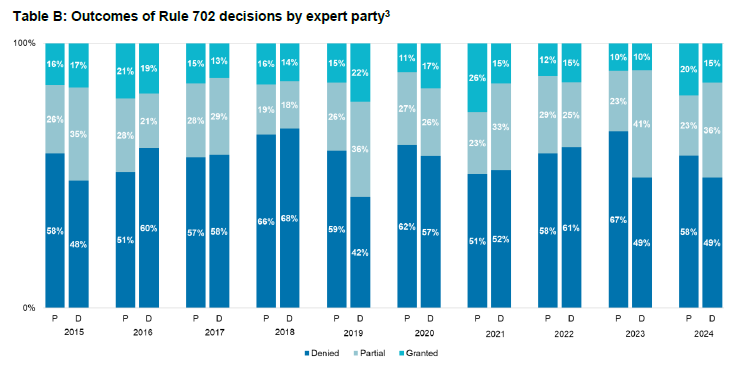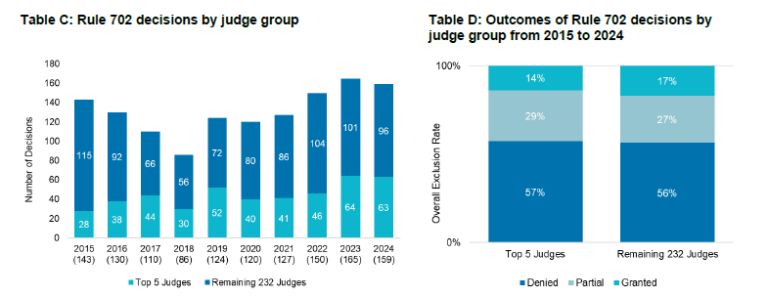In this CRA Insights, we update the Rule 702 decision trends in last year’s Insights with 2024 data. We also provide descriptions of two specific challenges in 2024 Rule 702 decisions.
Rule 702 decision trends are based on our review of available US district court decisions concerning damages experts in patent infringement matters that have sufficient information for analysis. The number of Rule 702 decisions available to analyze in 2024 was 159, slightly lower than 2023 (165 decisions) but higher than any other year during the 2015–2024 period analyzed in this newsletter. The overall exclusion rate in such decisions—where the court either granted or partially granted a motion to exclude or limit a damages expert’s testimony—was approximately 46%, higher than the 2022 and 2023 overall exclusion rates of approximately 41%. Overall exclusion rates from 2015 through 2024 are presented in Table A below.
We also analyze differences in exclusion rate between plaintiff’s experts and defendant’s experts. While the difference in overall exclusion rates between plaintiff’s and defendant’s experts has varied from year to year, over the entire 2015–2024 period, the overall exclusion rate has been slightly higher for defendant’s experts (46%) compared with plaintiff’s experts (41%). This difference in overall exclusion rates has been somewhat prominent in recent years, with the overall exclusion rate for defendant’s experts exceeding the overall exclusion rate for plaintiff’s experts by approximately 17% in 2023 and 8% in 2024. Overall exclusion rates from 2015 through 2024, by expert party (where “P” is plaintiff and “D” is defendant), are presented in Table B below.
From 2015 through 2024, 237 different judges have ruled on at least one Rule 702 decision that has been analyzed in this newsletter. Five judges have ruled on over 34% of these decisions (446 out of 1,314 total decisions). Each of these five judges has ruled on at least 64 decisions over the 2015–2024 period, while the average number of decisions for the remaining 232 judges is fewer than four, with no judge ruling on more than 30 decisions. Despite the difference in the number of decisions per judge, each group of judges (top five compared with the remaining 232) had similar overall exclusion rates, demonstrating general consistency with how Rule 702 is applied by judges with different levels of Rule 702 experience. The number of decisions and overall exclusion rates for each group of judges are presented in Tables C and D below.
As discussed in prior CRA Insights, the Supreme Court approved a clarifying amendment to Federal Rules of Evidence Rule 702 that went into effect on December 1, 2023. As demonstrated in the statistics above, the amendment has not shown to have a material impact on exclusion rates in Rule 702 decisions. For example, while the 2024 exclusion rate was somewhat higher relative to 2023 and 2022, the exclusion rate for 2024 was generally consistent with (although still slightly higher than) the overall exclusion rate for the 2015‒2023 period. This would suggest that courts view the amendment as a clarification of the rule, rather than a change in the threshold of admissibility. For example, the following excerpts from Rule 702 decisions in non-patent cases (i.e., not included in the statistics above) provide instances where courts have explicitly disclosed that their decisions in those cases were not impacted by the rule change:
- “The court’s decision would be the same under either version of the rule” (Memorandum and Order, December 28, 2023, Bextermueller News Distributors, Inc. et al. v. Lee Enterprises, Inc. et al., Case No. 4-22-cv-00344).
- “The court recites the rule in its amended form in this Order, but the court’s analysis and rulings remain the same under the previous and the current versions of the Rule” (Memorandum Order, December 29, 2023, Kevin Brown, et al. v. Saint-Gobain Performance Plastics Corporation, et al., Case No. 1-16-cv-00242).
- “The Advisory Committee Notes clarify that the 2023 amendment does not ‘impose any new, specific procedures,’ but instead the amendment was made to clarify the preponderance standard for the admissibility requirements set forth in the Rule and to emphasize that an expert ‘must stay within the bounds of what can be concluded from a reliable application of the expert’s basis and methodology.’ … The Court’s decision regarding the admissibility of Plaintiff’s expert would be the same under either version of the Rule.” (Memorandum and Order, January 18, 2024, Carolyn Thomas v. State Farm Mutual Automobile Insurance Company, Case No. 4-22-cv-00724).







